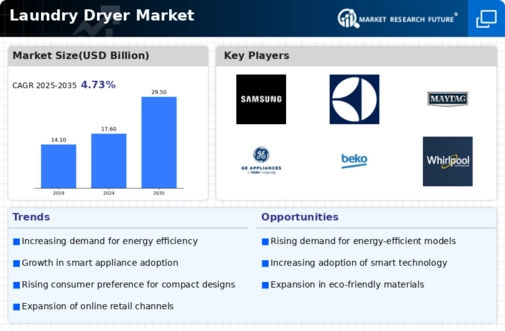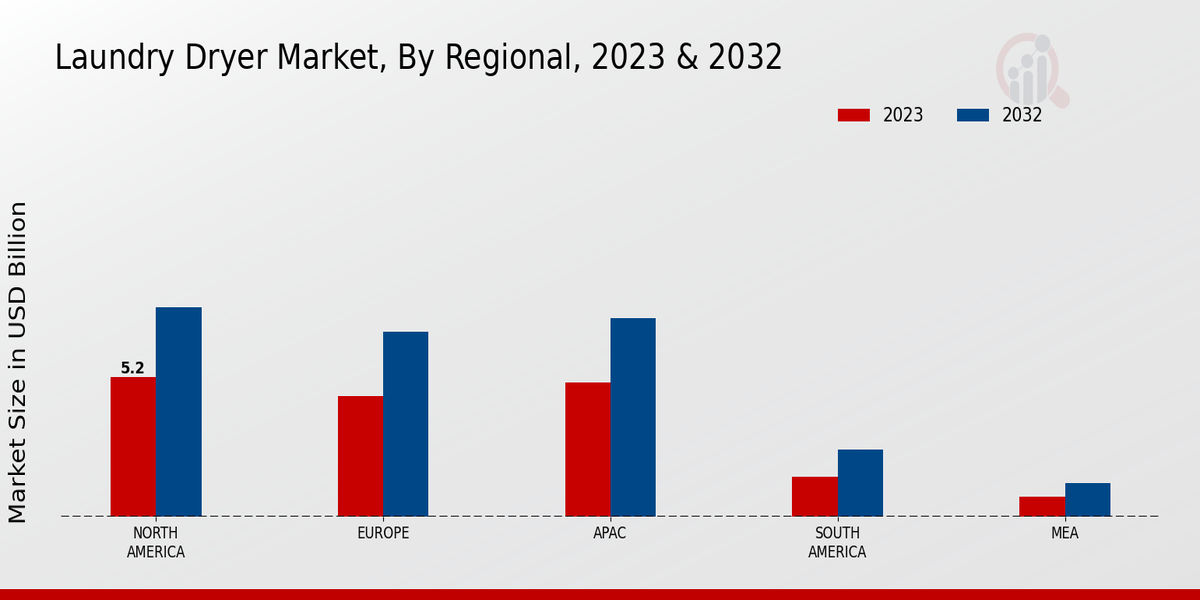Market Growth Projections
The Global Laundry Dryer Market Industry is poised for substantial growth, with projections indicating a market value of 29.5 USD Billion by 2035. This anticipated growth reflects a compound annual growth rate (CAGR) of 4.83% from 2025 to 2035, driven by various factors including technological advancements, urbanization, and increased consumer spending. The market dynamics suggest a robust demand for innovative and efficient laundry solutions, as consumers increasingly prioritize convenience and sustainability. As the industry evolves, stakeholders must remain attuned to emerging trends and consumer preferences to capitalize on the growth opportunities that lie ahead.
Increased Disposable Income
The Global Laundry Dryer Market Industry benefits from rising disposable incomes across various regions, particularly in developing economies. As consumers gain more financial flexibility, they are more inclined to invest in household appliances that enhance their quality of life. This trend is evident in the growing sales of laundry dryers, as households prioritize convenience and efficiency. The correlation between increased disposable income and appliance purchases suggests a robust market potential. With the market projected to reach 17.6 USD Billion in 2024, the impact of rising incomes on consumer spending behavior is likely to be a driving force in the industry.
Urbanization and Changing Lifestyles
Urbanization significantly impacts the Global Laundry Dryer Market Industry, as more individuals and families move to urban areas where space constraints often limit laundry options. In densely populated cities, the convenience of having a dryer becomes paramount, leading to increased adoption rates. Additionally, changing lifestyles, characterized by busy schedules and a preference for time-saving appliances, further drive demand. As urban populations continue to grow, the market is expected to expand, with a projected CAGR of 4.83% from 2025 to 2035. This trend highlights the necessity for manufacturers to cater to the evolving needs of urban consumers.
Growing E-commerce and Online Retail Channels
The rise of e-commerce has transformed the Global Laundry Dryer Market Industry by providing consumers with greater access to a diverse range of products. Online retail channels enable consumers to compare prices, read reviews, and make informed purchasing decisions from the comfort of their homes. This shift towards online shopping is particularly relevant in the context of laundry dryers, where consumers seek convenience and competitive pricing. As e-commerce continues to expand, it is expected to contribute to the overall growth of the market, facilitating a more streamlined purchasing process and enhancing consumer engagement.
Rising Demand for Energy-Efficient Appliances
The Global Laundry Dryer Market Industry experiences a notable shift towards energy-efficient appliances, driven by increasing consumer awareness regarding environmental sustainability. As households seek to reduce energy consumption, manufacturers are responding by developing dryers that utilize advanced technologies, such as heat pump systems. This trend is reflected in the projected market value of 17.6 USD Billion in 2024, indicating a growing preference for eco-friendly options. Energy-efficient models not only lower utility bills but also contribute to reduced carbon footprints, aligning with global initiatives aimed at combating climate change. Consequently, the demand for energy-efficient laundry dryers is expected to significantly influence market dynamics.
Technological Advancements in Drying Technology
Technological advancements play a pivotal role in shaping the Global Laundry Dryer Market Industry. Innovations such as smart dryers equipped with IoT capabilities allow users to monitor and control their appliances remotely, enhancing convenience and efficiency. Furthermore, the integration of sensors that optimize drying cycles based on fabric type and moisture levels contributes to improved performance. As consumers increasingly prioritize convenience and functionality, these technological enhancements are likely to drive market growth. The anticipated expansion of the market to 29.5 USD Billion by 2035 underscores the importance of continuous innovation in maintaining competitiveness within the industry.














